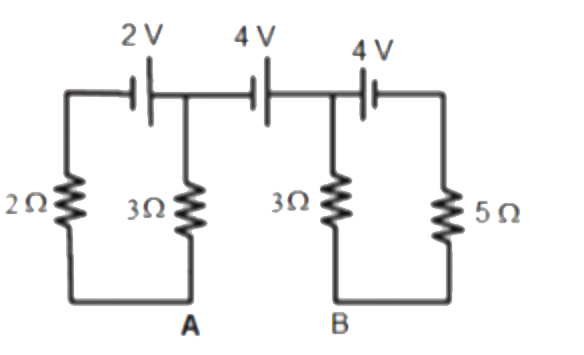Shows a potential divider circuit, which, by adjusctment of the position of the contact X, can be used to provide a variable potential difference betweenn the terminals P and Q. what are the limits of this potential difference?

A
0 and 20 mV
B
5 and 25 mV
C
0 and 20 V
D
0 and 25 V
Video Solution
Text Solution
The correct Answer is:C
Resistance across AC is more than CB.
|
Topper's Solved these Questions
- ELECTRIC CURRENT AND CIRCUITBOOK - CENGAGE PHYSICS ENGLISHCHAPTER - ELECTRIC CURRENT AND CIRCUITEXERCISE - Multiple Correct
16 Videos
- ELECTRIC CURRENT AND CIRCUITBOOK - CENGAGE PHYSICS ENGLISHCHAPTER - ELECTRIC CURRENT AND CIRCUITEXERCISE - Comprehension
35 Videos
- ELECTRIC CURRENT AND CIRCUITBOOK - CENGAGE PHYSICS ENGLISHCHAPTER - ELECTRIC CURRENT AND CIRCUITEXERCISE - Subjective
29 Videos
- ELECTRIC CURRENT & CIRCUITSBOOK - CENGAGE PHYSICS ENGLISHCHAPTER - ELECTRIC CURRENT & CIRCUITSEXERCISE - Kirchhoff s law and simple circuits
15 Videos
- ELECTRIC FLUX AND GAUSS LAWBOOK - CENGAGE PHYSICS ENGLISHCHAPTER - ELECTRIC FLUX AND GAUSS LAWEXERCISE - MCQ s
38 Videos
Similar Questions
Knowledge Check
In the given circuit, the potential difference between A and B is
 A10 VB15 VC20 VD5V
A10 VB15 VC20 VD5V
Find the potential difference between the points A and B in the circuit shoun in.
 .
.
View SolutionThe potential difference between the points P and Q in the adjoining circuit will be-

View SolutionIn given circuit , the potential difference between points A and B is

View SolutionIn the given circuit, potential difference between B and A is

View SolutionWhat is the potential difference between points A and B in the circuit shown?

View SolutionPotential difference across the terminal of a non ideal battery is
View SolutionIn the circuit below, the potential difference between A and B is

View Solution

